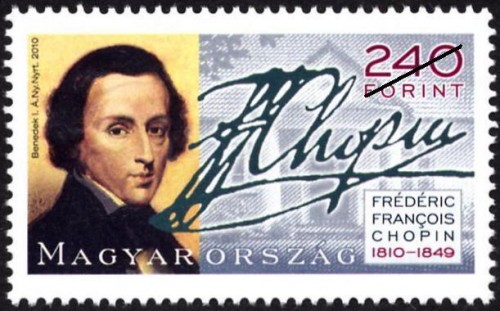
1. MAGYAR - 200 ÉVE SZÜLETETT FRÉDÉRIC FRANÇOIS CHOPIN - Bélyeg rendelési kód: 2010 év bélyegei kompletten
2. ENGLISH - BICENTENARY OF THE BIRTH OF FRÉDÉRIC FRANÇOIS CHOPIN - Order code of the stamp: 2010 Year stamps complete
3. GERMAN - 200. GEBURTSTAG DES KOMPONISTEN FRÉDÉRIC FRANÇOIS CHOPIN - Die Bestellnummer Der Marke: 2010 Jahr Briefmarken komplett
Michel:
1. MAGYAR - 200 ÉVE SZÜLETETT FRÉDÉRIC FRANÇOIS CHOPIN
A zongora költőjének is nevezett Frédéric François Chopin a klasszikus zene egyik legnagyobb alkotója. A XIX. század első felében élt zeneszerző a nemzeti romantika és a népzenei motívumok felhasználásának előfutára volt. A 2010-es évet az UNESCO Chopin évvé nyilvánította, ebből az alkalomból bocsátja ki a Magyar Posta ünnepi bélyegét.
Frédéric François Chopin, eredetileg Fryderyk Franciszek Chopin (Żelazowa Wola, 1810. március 1. – Párizs, 1849. október 17.) lengyel zeneszerző és zongoravirtuóz. Zenei tehetségét nagyon fiatalon felismerték; zsenialitása a gyermek Mozarthoz vagy Bach-hoz mérhető. Hét évesen már két polonézt szerzett. A csodagyerek hamarosan a fővárosi arisztokrata szalonok látványossága lett, és számos jótékonysági koncertet is adott. Első zenetanára 1816-22 között Wojciech Żywny hegedűművész volt.
Tehetségének további fejlesztését Wilhelm Würfel (Václav Wefel), neves zongorista és a Varsói Konzervatórium professzora vette át. 1823-26 között a varsói líceumba járt. 1826 őszétől zeneelméletet és zeneszerzést kezdett tanulni a Varsói Konzervatóriumban. 1829-ben járt először Bécsben, ahol zongorakoncerteket is adott. A következő évben visszatért Varsóba, ahol a Nemzeti Színházban bemutatta f-moll zongoraversenyét. 1831-ben örökre elhagyta Lengyelországot, és Párizsban telepedett le. 1835. augusztus 1-jén megkapta a francia állampolgárságot. Ezidőtájt kezdődött az életét végigkísérő harca a tuberkulózissal.
Zongoramuzsikája egyedülállóan ötvözi különleges ritmusérzékét, Johann Sebastian Bach stílusát, továbbá a maga alkotta zongoratechnikát. A zeneszalonokkal megismertette az ír John Field által kitalált noktürn egy magasabb szintre emelt változatát, valamint olyan népszerű tánczenéket, mint a lengyel mazurka vagy a bécsi keringő.
Chopin szerzett először balladákat, és önálló darabként scherzókat. A Bach-féle prelűdök továbbfejlesztése is neki köszönhető. Egyedi és könnyen megjegyezhető melódiájának köszönhetően több dallama is közismertté vált. Stílusa és tehetsége sokakra hatott: Robert Schumann nagy rajongója volt, dallamokat vett át tőle és Karnevál szvitjének egy tételét is róla nevezte el; Liszt Ferenc, akivel többször tartottak közös koncertet, számos darabját dolgozta át szóló zongorára.
Az 1840-es évekre egészsége gyorsan kezdett romlani. 1849-re fő művei elkészültek, és a mazurkákra valamint a noktürnökre összpontosított. Tuberkulózisban halt meg 1849. október 17-én. Bár a párizsi Père Lachaise temetőben helyezték végső nyugalomra, szívét és a levelezéseit a varsói Szent Kereszt templomban őrzik. (Forrás: hu.wikipedia)
Az alkalmi bélyegen Frédéric François Chopin portréja, szülőháza és aláírása látható. A bélyeghez tartozó alkalmi boríték és alkalmi bélyegző grafikájának középpontjában Chopin legkedvesebb hangszere, a zongora áll. Az alkalmi borítékon a zongoránál ülő művész sziluettje, az alkalmi bélyegzőn a zongorán játszó kezek stilizált rajza található.
Forrás: Magyar Posta
2. ENGLISH - BICENTENARY OF THE BIRTH OF FRÉDÉRIC FRANÇOIS CHOPIN
Frédéric François Chopin, known as the poet of the piano, was one of the greatest composers of classical music. The musician, who lived in the first half of the 19th century, was the pioneer of the use of national Romantic and folk music motifs. 2010 has been declared the year of Chopin by UNESCO and Magyar Posta is marking the occasion by releasing a celebratory stamp.
Frédéric François Chopin, originally Fryderyk Franciszek Chopin (Żelazowa Wola, 1 March 1810 – Paris, 17 October 1849), was a Polish composer and piano virtuoso. His musical talent was spotted very early, his genius as a child being compared to Mozart or Bach. At the age of seven he had already composed two polonaises.
The child prodigy soon graced the salons of the noble families of the Polish capital and gave numerous charity concerts. His first music teacher between 1816-22 was the violinist Wojciech Żywny. His talent was further nurtured by the celebrated pianist and professor at the Warsaw Conservatory, Wilhelm Würfel (Václav Wefel). He attended the Warsaw Lyceum between 1823-26. In the autumn of 1826 Chopin began studying music theory and composition at the Warsaw Conservatory. He first went to Vienna in 1829, where he gave piano recitals.
The following year he returned to Warsaw, where his Piano Concerto in F minor was premiered in the National Theatre. In 1831 he left Poland forever and settled in Paris. On 1 August 1835 he became a French citizen. About this time his struggle with tuberculosis, which was to dog him for the rest of his life, began.
His piano music is a unique blend of his exceptional sense of rhythm, Johann Sebastian Bach’s style, and the piano technique he created himself. He brought the genre of the nocturne, invented by the Irish composer John Field which he took to a higher level of sophistication, as well as popular dance music such as the Polish mazurka and the Viennese waltz to the music salons. Chopin was the first to write ballads and scherzi as individual works. He also transformed the form of the prelude from Bach’s model. Thanks to his distinctive and memorable melodies, many of his tunes became very well-known. His style and talent influenced many: Robert Schumann was a great admirer of him, and used melodies by Chopin, even naming a movement of his suite Carnaval after him. Franz Liszt, with whom Chopin held several joint concerts, adapted many of his pieces for solo piano.
In the 1840s his state of health began to deteriorate rapidly. By 1849 his main works had been composed and he concentrated on mazurkas and nocturnes. Chopin died of tuberculosis on 17 October 1849. Although he was laid to rest in the Père Lachaise cemetery in Paris, his heart and his correspondence are in the Holy Cross Church in Warsaw. (Source: hu.wikipedia)
On the special stamp there is a portrait of Frédéric François Chopin, the house where he was born and his signature. At the centre of the design of both the first day cover and the commemorative postmark is Chopin’s favourite instrument, the piano. The first day cover shows a silhouette of Chopin seated at the piano and in the postmark there is a stylised design of hands playing a piano.
3. GERMAN - 200. GEBURTSTAG DES KOMPONISTEN FRÉDÉRIC FRANÇOIS CHOPIN
Frédéric François Chopin – der Dichter des Klaviers – ist einer der größten Schöpfer der klassischen Musik. Der in der ersten Hälfte des 19. Jahrhunderts lebende Komponist war der Vorläufer der Verwendung von national-romantischen und volkstümlichen Motiven. Die UNESCO-Generalkonferenz erklärte 2010 zum Internationalen Chopinjahr, die Magyar Posta bringt zu diesem Anlass eine Sonderbriefmarke heraus.
Frédéric François Chopin, ursprünglich Fryderyk Franciszek Chopin (Żelazowa Wola, 1. März 1810 – Paris, 17. Oktober 1849) polnischer Komponist und Klaviervirtuose. Sein musikalisches Talent ist sehr früh erkannt worden; seine Genialität ist mit der von Mozart oder Bach als Kind zu vergleichen. Mit sieben hatte er bereits zwei Polonaisen komponiert.
Schon bald war das Wunderkind die Attraktion der aristokratischen Salons der Hauptstadt und es gab auch zahlreiche Wohltätigkeitskonzerte. Sein erster Musiklehrer zwischen 1816 und 1822 war der Violinvirtuose Wojciech Żywny. Die weitere Förderung seines Talents übernahm der berühmte Klavierspieler und Professor am Warschauer Konservatorium Wilhelm Würfel (Václav Wefel). Zwischen 1823 und 1826 besuchte Chopin das Warschauer Lyzeum.
Im Herbst 1826 begann er am Warschauer Konservatorium Musiktheorie und Komponieren zu studieren. 1829 reiste er das erste Mal nach Wien, wo er auch Klavierkonzerte gab. Im darauf folgenden Jahr kehrte er nach Warschau zurück, wo er am Nationaltheater mit seinem Klavierkonzert Nr. 2 in f-Moll debütierte. 1831 verließ er Polen für immer und ewig und ließ sich in Paris nieder. Am 1. August 1835 erhielt er die französische Staatsbürgerschaft. Etwa zu jener Zeit begann sein Kampf gegen die Tuberkulose, der ihn Zeit seines Lebens begleitet hat.
Seine Klaviermusik vereinigt einzigartig sein besonderes Rhythmusgefühl, den Stil von Johann Sebastian Bach sowie seine selbst geschaffene Klaviertechnik. Er machte die Musiksalons mit der auf ein höheres Niveau gebrachten Variation der von dem Iren John Field begründeten Nocturne sowie mit solch beliebten Tanzmusiken bekannt wie die polnische Mazurka oder der Wiener Walzer. Chopin komponierte erstmals Balladen und Scherzos als eigenständiges Stück.
Auch die Weiterentwicklung der Bach-Préludes ist ihm zu verdanken. Viele seiner Werke sind dank ihrer individuellen und leicht merkbaren Melodie weltbekannt geworden. Sein Stil und sein Talent hatten großen Einfluss auf zahlreiche Komponisten: Robert Schumann war ein großer Anhänger von Chopin, er übernahm Melodien von ihm und benannte auch einen Satz seiner Suite Karneval nach ihm; Franz Liszt, mit dem sie mehrmals gemeinsame Konzerte gaben, hat viele seiner Werke für Solo-Klavier neu bearbeitet.
In den 1840er Jahren begann sich sein Gesundheitszustand schnell zu verschlechtern. Bis 1849 waren seine Hauptwerke vollendet und er konzentrierte sich auf die Mazurken sowie die Nocturnes. Er starb am 17. Oktober 1849 an Tuberkulose. Obgleich er im Pariser Friedhof Père Lachaise zur letzten Ruhe getragen wurde, wird sein Herz und seine Korrespondenz in der Heiligkreuzkirche in Warschau gehütet. (Quelle: hu.wikipedia)
Auf der Sonderbriefmarke sind Frédéric François Chopins Porträt, Geburtsstätte und Unterschrift zu sehen. Hauptmotiv der Grafik des zur Briefmarke gehörigen Sonderumschlags und Sonderstempels ist das Klavier, Chopins liebstes Instrument. Auf dem Sonderumschlag ist die Silhouette des am Klavier sitzenden Künstlers, auf dem Sonderstempel die stilisierte Zeichnung der Klavier spielenden Hände aufzufinden.










